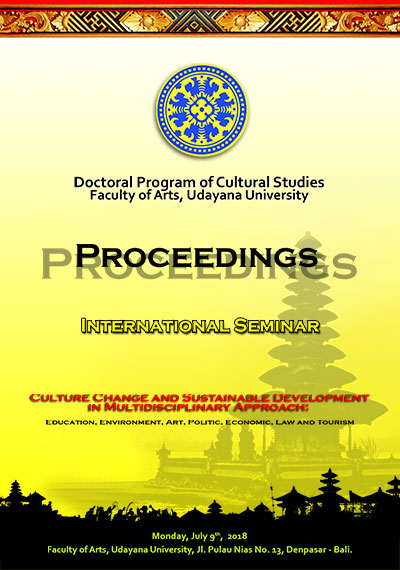IDENTITY CONCEPT OF SUMPINGAN KIWO IN WAYANG KRUCIL
Abstract
The aesthetic concept of “Nusantara” always puts everything with their respective spouses. The principle of opposition of the pair can be found in all aesthetic and ethical settings in “Nusantara”. Opposition partner pairs place the right status as the left pair, both as a bad pair, and also right as the wrong pair. The principle does not see good as opposed to ugliness, but as a partner that must be accommodated and arranged according to their respective portions. The principle of opposition of this pair can also be found in the chopper or the arrangement of wayang positions in Java. The wayang performance in Java always places a person who is considered bad or not good in the left position and a figure who is considered good in the right position. Right and left indicate the antagonistic and protagonist status in performance. In the wayang krucil chopsticks in East Java, the left figures are analogous as figures who oppose the concept of truth. Wayang krucil is a wooden puppet by taking the story of Babad Majapahit and the Babad Panji. In the story of the Babad Majapahit, the Kiwo sumpingan (left) shows figures who are considered to have rebellious nature and oppose royal policy. Figures of Klonosewandono, Menakjingo to Menakkoncar are positioned as left figures or bad figures. The placement of the left figure in this wayang krucil blowstick is interesting to study further, considering that in the present perspective the Banyuwangi community rejects the figure of Menak Jinggo as a bad characterist. The Klonosewandono figure was also rejected as a left figure by the Ponorogo community, remembering Prabu Klonosewandono as a core figure in the Ponogogo reog performance. The identity of the left and right chopsticks in wayang krucil can be seen as a classification of identity based on the legitimate perception of the Majapahit ruler at that time. Left and right in the Wayang Krucil chopsticks basically show the stigma given by the authorities to their political opponents using art media. Identity is built in the perception of power, so that it shows absolute good and bad positions.
Downloads
References
Sutopo, HB. 1996. Penelitian Kualitatif ( Sebuah Pendekatan Interpretatif Bagi Pengkajian Proses dan Makna Hubungan antar Subjektif), Surakarta, Universitas Sebelas Maret (UNS) Press; 29
Thompson, John B. 2015. Kritik Ideologi Global Teori Sosial Ktiris Relasi Ideologi dan Komunikasi Massa. Yogyakarta: IRCiSoD.
Wibowo, Anjar Mukti. 2015 Sejarah Kesenian Wayang Timplong Kabupaten Nganjuk dalam Jurnal Agastya Vol 5 No 2 Juli 2015
Zoemulder, P.J. 1990. Manunggaling Kawula Gusti Patheisme Dan Monoisme Dalam Sastra Suluk Jawa. Jakarta: Gramedia Pustaka Utama.
Agung Budi Sardjono dan Dhanoe Iswanto. 2012. Perubahan Bentuk Rumah Tradisional Pesisir JawaStudi Kasus Rumah Tradisional di Demak dan Kudus. Jurnal Lingkungan Binaan Indonesia Vol.1 No.1 Juli 2012 | 39
Akun; Endang Ernawati. 2012. Binary Opposition And Multiculturalism Shown In The Struggle Of Mataram Kingdom Power During Reign Of Amangkurat I. J u r n al Lingua Cultura Vol.6 No. 2 November 2012: 162-172
Ambary, Hasan Muarif. 1991. Peranan Cirebon Sebagai Pusat Perkembangan dan Penyebaran Islam. Artikel dalam Cirebon Sebagai Bandar Jalur Sutera. Jakarta: Departemen Pendiikan dan Kebudayaan RI.
Ambary, Hasan Muarif. 1998. Menemukan Peradaban Jejak Arkeologis dan Historis Islam di Indonesia. Jakarta: Logos.
B. Yudi Dwiandiyanta, Antonius Bima Murti Wijaya dan Martinus Maslim and Suyoto. 2012. New Shadow Modeling Approach Of Wayang Kulit. International Journal of Advanced Science and Technology Vol. 43, June, 2012
Barker, Chris. 2014. Kamus Kajian Budaya. Yogyakarta: Kanisius. Budi Utomo, 2015. “Fungsi Pertunjukan Wayang Krucil Lakon Bedhah Medhayin Dalam Upacara Manganan Janjang Di Kabupaten Blora”. Tesis Insitut Seni Indonesia Surakarta. Surakarta: Institut Seni Indonesia Surakarta.
Geertz, Cliford. Agama Jawa Abangan Santr Proyayi dalam Kehidupan Jawa. Depok: Komunitas Bambu. Hadi, Y. Sumandyo. 2006. Seni dalam Ritual Agama.Yogyakarta: Pustaka. Harker, Richard. 2005. (Habitus X Modal) + ranah= Praktik Pengantar Paling Komprehensif kepada Pemikiran Pierre Bourdieu. Yogyakarta: Jala Sutra
Koentjaraningrat. 1994. Kebudayaan Jawa. Jakarta: Balai Pustaka. Koentjaraningrat. 1996. Pengantar Ilmu Antropologi. Jakarta: Rineka Cipta. Laksono, P.M. 1990. Tradition In Javanese Sosial Structure Kingdom And Countryside. Yogyakarta: Gadjah Mada University Press.
Larrain, Jorge. 1996. Konsep Ideologi. Yogyakarta:LKPSM. Lombard, Denys. 1996. Nusa Jawa Silang Budaya Batas-Batas Pembaratan. Jakarta: Gramedia Pustaka Utama.
Magetsari, Noerhadi. Lokal Genius dalam Kehidupan Beragama. Artikel dalam Keppjbadian Budaya Bangsa (Lokal Genius). Jakarta: Pustaka Jaya.
Magnis-Suseno, Frans. 1995. Wayang Dan Panggilan Hidup Manusia. Jakarta: Gramedia Pustaka Utama.
Magnis-Suseno, Frans. 1996. Etika Jawa Sebuah Analisa Falsafi. Tentang Kebijaksanaan Hdup Orang Jawa. Jakarta: Gramedia Pustaka Utama.
Mapiare, Andi. 2009. Identitas Relegius di Balik Jilbab.Malang: UM press. Piliang, Yasraf Amir. 2010. Post Realitas REalitas Kebudayaan dalam Era Post-metafisika. Yogyakarta: Jalasutera.
Poespoprodjo, W (1991), Hermeneutik Kebudayaan, Bandung, Fakultas Ilmu Komunikasi Universitas Padjadjaran; 117-118.
Prijotomo, Josep. 1992. Ideas And Forms Of Javanese Architecture. Yogyakarta: Gadjah Mada University Press.
Read, Herbert. 1970. Art and Society. New York: Shoken Book. Ritzer dan Goodman. 2012. Teori Sosiologi Klasik – Post Modern Edisi Terbaru.Yogyakarta: Kreasi Wacana
Ritzer, George dan goodman, Douglas. 2010. Teori sosiologi: dari Teori klasik sampai perkembangan Mutakhir Teori Sosial Postmodern. Yogyakarta: kreasi Wacana.
Rohidi, Tjetjep. Rohendi .1992, Analisa Data Kualitatif (terjemah: Qualitative Data Analysis: Matthew B.Miles and A. Michhael Huberman), Jakarta, UI Press;1920
Sudikan, Setyo Yuwono. 2000. “Pergelaran Wayang Krucil di Desa Janjang Kecamatan Jiken Kabupaten Blora Era 1990-an: Kajian Hegemoni Negara di Tingkat Lokal Melalui Kesenian Rakyat”. Disertasi. Surabaya: Program Pascasarjana Universitas Airlangga. Sumardjo, Jakob. 2014. Estetika Paradoks. Bandung: Kelir.





